| Since
the1960s, BV has been privileged to work with the ornamentation of
public buildings. To begin with, the pieces he created had a decorative
function only. Later, they were developed to become an integrated
part of the whole/environment.
His first
major commission in 1965 - for the Swedish Lloyd shipping company's
boat, the MS Saga - was a decoration executed in wrought-iron and
ceramic. Inspired by the ship 'Rijkswasa' (which sank in 1623),
Bertil created a 12 metre-long relief. It was followed by a smaller
ceramic bas-relief, based on the theme of 'sailors' yarns'. His
work received a good press, though it was 'thumbs down' for the
overall interior design of the ship.
Since then, the vessel has been sold many times over, and these
decorative murals have been
lost.
Over
the years, BV has been engaged for 22 commissions, the most prestigious
of which is the altarpiece in Växjö Cathedral, completed
in 2000 (see separate article on the website). In this article I
will concentrate on the most important of the public installations:
those in Caroli City and the Telia head office, Malmö; the
Volvo Head Office, and the Corning Museum.
In 1973,
visitors to the shopping centre, Caroli City, in the centre of Malmö,
could see a Zeppelin suspended from the ceiling, and a little further
on, a hot-air balloon, both of considerable size. The long, narrow
Zeppelin is almost ten metres long and about 3 metres high; the
balloon some four metres high. These mobile sculptures - constructed
in metal (mainly brass), are fanciful creations, but in the bustling
atmosphere of a shopping mall, they do not, alas, come into their
own. Four years later Bertil returned to Malmö, to create his
first really successful ornamental work, where art and milieu are
harmoniously integrated. Bertil was given a free rein with a circular
customer reception hall. He painted figures of birds and flying
men against a blue background - motifs found on his sandblasted
bowls of the same period. Under the skylight floats a large wooden
figure wearing a top hat. Beneath this figure there are plants and
a sculpture shaped like a tuning-fork, with a face and two large
funnels for ears. Above the face is a watching eye. From the face
water runs from the mouth and the eyes. This decorative piece has
a mysterious potency. The visitor is at one with the milieu, communication
is the password. We would like to speak to the weeping face and
follow the wooden man up to the light, but despite the solidarity
we feel, we cannot reach them.
During
the 80s, as Vallien's renown grew, the commissions became ever more
numerous. His greatest triumph - in 1987, was for Volvo (private
automobiles section), which was in need of an artistic decoration
for the deep light-well in their head office. BV decided on a large
sandblasted glass boat as the basis for the journey of the god,
Janus - destination unknown.
He described
this journey during the long, and arduous working process. "A
sea of thoughts and memories. An oasis of hopes - poetic spaces.
Becalmed. Nourishment for the imagination - our most valuable capital
asset. Water - mutability - movement - a sail. The god Janus who
gives his name to January portrayed with two faces - sees the past
and the future. The marble floor represents History. The watery
plate of glass - the sail. The future unknown - symbolised by the
crystal palace where the water ends its course. The boat represents
the journey!"
'Journey
of Janus' is a stunning work and makes great demands on the viewer.
Firstly, it is extremely high. Rising from a base of white marble,
is a 20 m high narrow sail constructed of aluminium-framed panes
of glass, with water trickling from top to base. The sail rests
on a four-ton slab of red granite. Beside the sail, a sandblasted
boat, 4 metres in length, suspended in steel wires. Higher up is
the map, and a long wooden rod that represents the compass needle.
Another boat that sails to an unknown destination is 'Voyage of
Janus II', to be found at the Corning Museum's head office, outside
New York. Bertil worked on this piece 1992-3. If 'Janus Journey
I' left visitors speechless on account of its size and splendour,
the Corning installation is a marvel of minimalist mystique. The
first journey of Janus was undertaken under the banner of hope.*
The second is as dark as night. Here, the boat hovers above a circular
granite slab, whose surface bears arcane inscriptions, its centre
filled with water. The boat is the key to the puzzle; plumbing the
still ocean of transience.
|
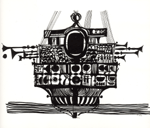
A
sketch for a wsought - iron relief, 1965.
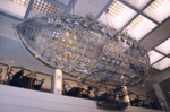
Zeppelin,
Caroli City, Malmö.

A
part of Bertil´s commission for Telias huvudkontor i Malmö.
Foto: Ola Terje.
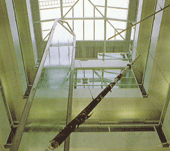
Journey
of Janus, Volvo, Gothenburg. Photo: Jan Olsson.
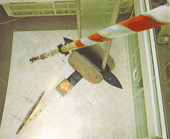
Journey
of Janus. Photo: Jan Olsson.
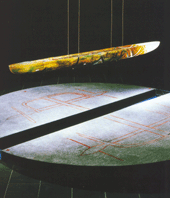
Voyage
of Janus II. Corning Inc, New York.
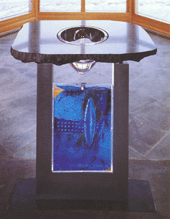
Baptismal
font for the Stenhagskyrkan in Uppsala, 1993.
|


